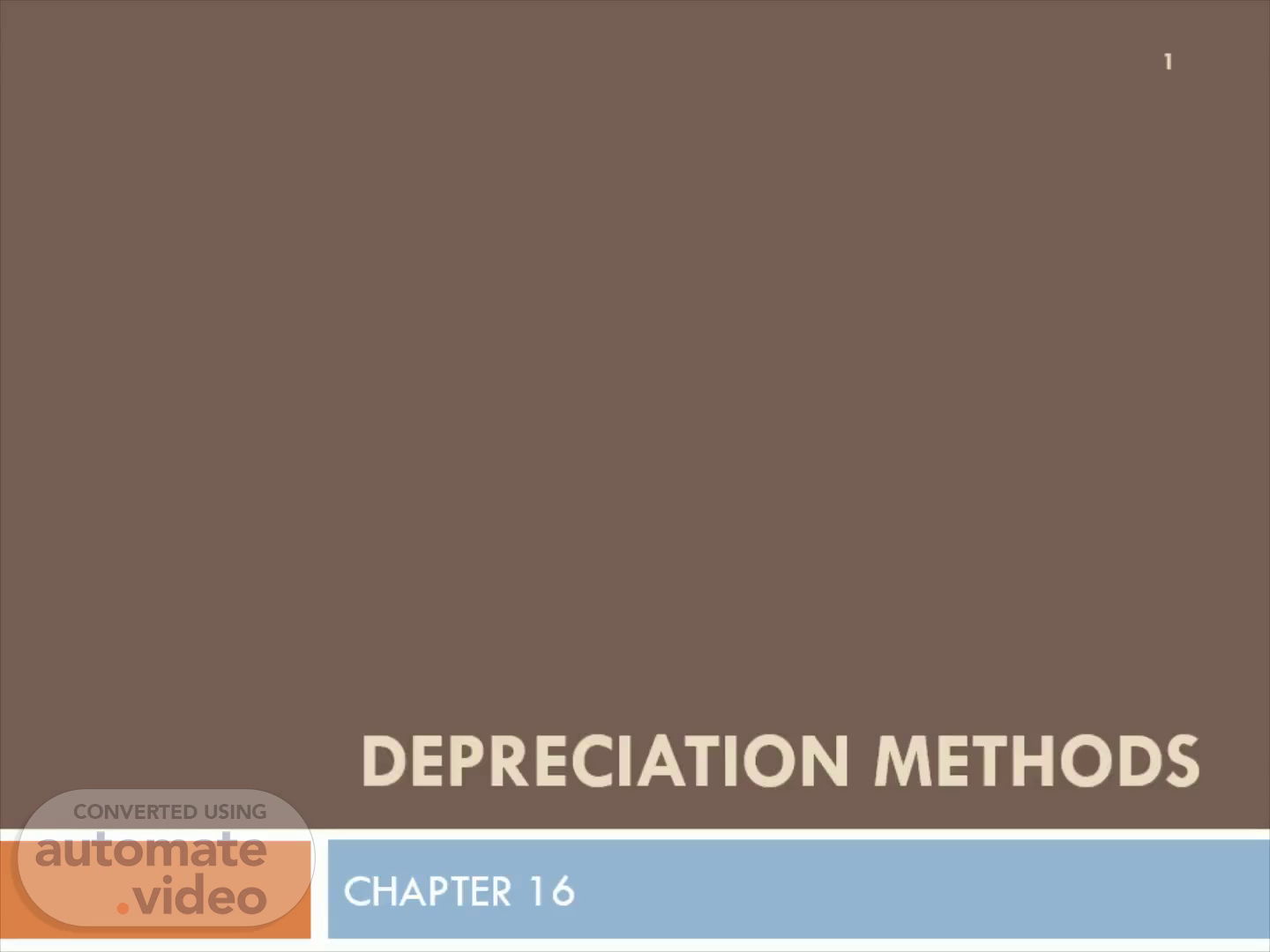
Page 1 (0s)
Depreciation methods. CHAPTER 16. 1.
Page 2 (11s)
LEARNING OUTCOMES. 2. The depreciation terms. How to apply the straight line model of depreciation . How to apply the declining balance models of depreciation ..
Page 3 (1m 38s)
3. Depreciation is the reduction in value over time of an asset . Brought on by: Wear and tear, use; Deterioration; Obsolescence. First Cost or Unadjusted Basis - B Initial purchase price + all costs incurred in placing the asset in service i.e. installation, delivery, etc. Book Value - BV Remaining un-depreciated capital investment on the accounting books ..
Page 4 (5m 21s)
16.1 Depreciation Terminology. Recovery Period – n Depreciable life of the asset in question . Market Value - MV The value of the asset on the open market if sold now, regardless of book value (depreciated value). Salvage Value - S Estimated trade-in value or market value at the end the asset’s useful life. Depreciation Rate - d t The rate of asset reduction each year . Personal Property All property except real estate used e.g. machinery, equipment, vehicles, telephone, computers, furniture, etc. ..
Page 5 (5m 44s)
Real Property. Are the real estate possessions of a company e.g. office building, warehouses, etc..
Page 6 (5m 59s)
Modified accelerated cost recovery system (MACRS).
Page 7 (9m 37s)
(B. Notation: D B S year (t annual depreciation charge first cost or unadjusted basis Estim ated salvage value recovery period depreciation rate.
Page 8 (13m 32s)
[Audio] B (first cost) - tDt (annual depreciation charge) Do example 16.1.
Page 9 (16m 9s)
If an asset has a first cost of $50,000 with $10,000 estimated salvage value after 5 years,.
Page 10 (19m 22s)
t D t BV t 1 $8,000 $42,000 2 8,000 34,000 3 8,000 26,000 4 8,000 18,000 5 8,000 10,000.
Page 11 (22m 29s)
If an asset has a first cost of $200,000 and has no salvage value after 8 years..
Page 12 (26m 55s)
The decline balance (DB) is an accelerated depreciation method, which is also known as the fixed percentage method..
Page 13 (31m 55s)
If BV t-1 is given, apply:. abstract. 16.3 Declining Balance (DB) and Double Declining Balance (DDB) Depreciation.
Page 14 (34m 51s)
The book value in year t can be determined either by:.
Page 15 (36m 40s)
[Audio] It is important to understand that the book value for the DB method never goes to zero, because the book value is always decreased by a fixed percentage.
Page 16 (38m 58s)
[Audio] Do example 16.2 16.3 using both approaches in second example to get Dt 1- BVt-1 is unknown, the depreciation can be calculated using the first cost Implied d = 1- (S/B)1/N Dt = dB(1-d)t-1 Then for continuous Dt-n Dt = (d)BVt- 1 2- Subtracting the current depreciation charge from the previous book value BVt=BVt-1 – Dt.
Page 17 (41m 59s)
SL $. DB %. DDB %. d MAX = 2(1/n). abstract. d t =.
Page 18 (46m 59s)
B-S. Example: Straight Line (SL). An asset that is book depreciated over a 5 year period by the straight line method has BV3 = $62,000 at year 3 and Dt = $26,000 per year. Determine (a) the first cost of the asset (b) the salvage value.
Page 19 (51m 1s)
B-S. Example: Straight Line (SL). D3 = 26,000 BV3 = 62,000 = B – 3(26,000) B = $140,000 (b) 26,000 = (140,000 – S)/5 S = $10,000.
Page 20 (51m 14s)
Example: Declining Balance (DB). A welding machine was purchased for use in a construction project. The welding machine will be DB depreciated over an expected life of 12 years . There is a first cost of $50,000 and a salvage of $500. (a) Calculate the depreciation rate. (b) Calculate the depreciation for year 5. (c) Calculate the book value for year 5. (d) Calculate the implied salvage value after 12 years..
Page 21 (52m 57s)
(p. The depreciation rate, depreciation amount, and book value.
Page 22 (57m 15s)
imp S. Example: Declining Balance (DB). The implied salvage value after 12 years.
Page 23 (58m 31s)
Example: Straight Line (SL) and Declining Balance (DB).
Page 24 (1h 0m 54s)
B = $800,000; n = 30; S = 15% = $ 120,000. Example: Straight Line (SL) and Declining Balance (DB).
Page 25 (1h 3m 22s)
B = $800,000; n = 30; S = 15% = $ 120,000. Example: Straight Line (SL) and Declining Balance (DB).
Page 26 (1h 5m 7s)
[Audio] See example 5.2. Rectangle: Click to edit Master text styles Second level Third level Fourth level Fifth level.
Page 27 (1h 5m 24s)
Example: Straight Line (SL) and Declining Balance (DB).
Page 28 (1h 5m 36s)
a) the market value (book value) amount in year 5, using DB method..
Page 29 (1h 5m 47s)
If the machine will have BV = 0 at the end of 5 years, the SL.
Page 30 (1h 6m 4s)
B-S n. Example: Straight Line (SL) and Declining Balance (DB).
Page 31 (1h 6m 12s)
[Audio] . Summary of Important Points. Depreciation is the reduction in value over time of an asset ..